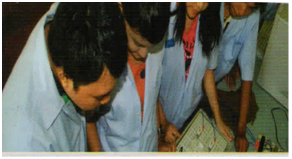Introduction
Formerly Department of Electrical Engineering established in 1987 by the Decree No.03/DJ/Kep/1979 had 2 study programs, Electronics and Telecommunications Engineering (ECTC) and Electrical Engineering Study Programs. Since 1991 Electrical Engineering Department based on The Decree of the Minister of Education and Culture of the Republic of Indonesia No. 0313/O/1991 has had three study programs namely Electrical Engineering, Electronics Engineering and Telecommunications Engineering Study Programs. Telecommunications Engineering Study Program (D III) is currently accredited B based on the decree No. 004/BAN-PT Ak-X/Dipl-III/VI/2010. It is under Quality Management System (QMS) ISO 9001: 2008 for its managerial process.
Vision
Telecommunications Engineering Program is a leading, powerful, innovative and qualified study program of vocational education in telecommunications. It helps to promote community life based on the Five Principles and the Constitution of ’45.
Mission
- Producing qualified, professional, and disciplined graduates that can apply science, technology and art (science and technology) of Telecommunications Engineering;
- Improving, developandapplyscience and technologyfornational development;
- Increasing mutual benefit cooperation with industry in order to improve the quality of graduates.
Purposes
- To produce mid-level managers that are professionalinTelecommunications thathave the following competences;
– Radio and Television Communications;
– Cellular Communications;
– Technology Network.
- 2. To produce graduates that can be absorbed by Telecommunications labor market and are able to adapt to the development of the industrial world.
Targets
- Have good morale, devotion to God Almighty, and environmental care.
- Able to operate, calibrate, maintainandrepair instrument toolsandtelecommunications equipment, carry outthe installationandrepairof telecommunicationnetwork equipment;
- Able to carry out theinstallation, maintenance of radio receiver andtransmitter, TVandPABX based on appropriateapplicableregulations;
- Able tousecomputer technologytodesigndevicesandtelecommunication networks;
- Able to competein globalization era.
Strategies to Achieve Targets
- Provide structural and dynamic learning methods, which include;
- Curriculum design with 59% practical and 41% theory ratio;
• Appropriate materials as stated in the syllabus;
• Optimization of supporting facilities for learning process
• Optimization the use of laboratory and workshop facilities to achieve
appropriate skill competencies;
• Optimization the use of computer technology for device design and telecommunication network.
- Providesupportforfaculty and studentsto write scientific articles at least once within asemesterandengage studentsinresearchonce a year andattend seminars/conferences/scientific forumsontelecommunicationnetworktechnologies.
Conduct seminars on motivation by inviting experts in order to improve students’ motivation and achievement;
• Intensify the role of academic supervisors;
• Cooperate closely with industry in conducting research;
• The average number of research activities is five within one academic year.
- Cooperate with industry and alumni in exchanging information about the needs in designing a competency- based curriculum.
- Involve lecturers in tracer studies related to industry and governmental agencies in implementing partnership programs;
- Distribute questionnaire for the purposes of relevant changes in educational curriculum in order to develop human resources.
Graduates’ Profile
Telecommunications Engineering organizes 3 years or 6 semesters of education with 41% theory and 59% practice ratio. The class for theory is conducted in the classroom equipped with white board, and infocus while practical activities / practices are carried out in the laboratories / workshops. Telecommunications Engineering graduates have the following competences:
- In transmitter and receiver of Radio and Television communications;
• In GSM and CDMA mobile communication;
• In LANs, WANs and the Internet network technologies.
Learning Outcomes
- 1. Master basics of telecommunication science especially telecommunications network;
- 2. Able to design, build and maintain telecommunications network;
- 3. Able to solve problem by evaluating the instrumentation and by using appropriate methods.
Graduates’ Competences
Core Competences
• Communication of radio and television;
• Mobile Communications;
• Network technology.
Supporting Competences
Design and maintain telecommunication devices
Other Competence
Entrepreneurship
Facilities
8 laboratories with the newest facilities:
- 1. High Frequency Laboratory
2. Basic Telecommunications Laboratory
3. Analog and Instrument Tools Laboratory
4. Data Communications Laboratory
5. Microprocessor Laboratory
6. Transmission Laboratory
7. Digital Lababoratory
8. Signal processing Lababoratory - Mechanicsworkshop
- Electronicsworkshop
- A cooperative (economic enterprise)
- Student Association Room

